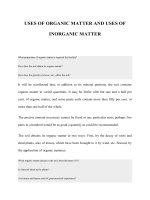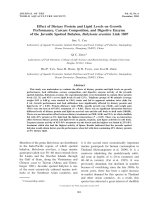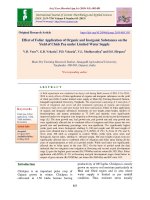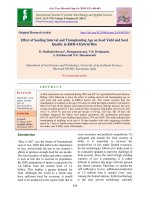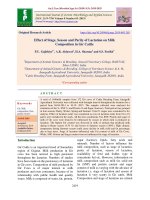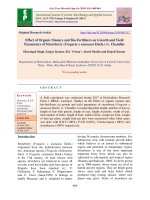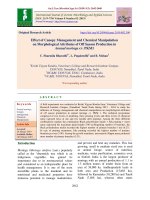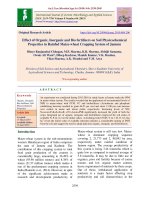Effect of organic manures and inorganic fertilizers on soybean yield, nutrient content and uptake
Bạn đang xem bản rút gọn của tài liệu. Xem và tải ngay bản đầy đủ của tài liệu tại đây (261.07 KB, 9 trang )
Int.J.Curr.Microbiol.App.Sci (2019) 8(5): 2283-2291
International Journal of Current Microbiology and Applied Sciences
ISSN: 2319-7706 Volume 8 Number 05 (2019)
Journal homepage:
Original Research Article
/>
Effect of Organic Manures and Inorganic Fertilizers on Soybean Yield,
Nutrient Content and Uptake
Rani Bathula1*, Rajeshwar Malawath1, T. Anjaiah1 and M. Govardhan2
1
Department of Soil Science and Agriculture Chemistry, 2AICRP on Integrated Farming
System, P.J.T.S.A.U, Hyderabad, Telangana, India
*Corresponding author
ABSTRACT
Keywords
Soybean, FYM,
Leaf fall, Nutrient
uptake
Article Info
Accepted:
18 April 2019
Available Online:
10 May 2019
A field experiment was conducted at research farm of Agricultural Research Institute
(ARI), Rajendranagar, Hyderabad, Telangana. The experiment was laid out in factorial
combination of with and without leaf fall and increasing levels of N along with FYM
application in randomized complete block design, each plot measuring 6.1 m x 4.2 m and
three replications. ADB-22 (Bhasar) a high yielding variety of soybean was used as the test
crop in this experiment. The soil was black clay in texture and moderately alkaline (pH
8.4) in reaction, non-saline in nature (EC 0.16dS m-1) and high in organic carbon content
(0.67%). The experiment consisted treatments were viz.,75% RDF, 100% RDF, 75% RDF
+ FYM @ 5 t ha-1, 100% RDF + FYM @ 5 t ha-1 and in addition absolute control was
maintained. The highest grain yield2318 kg ha-1 was recorded with application of 100%
RDF + FYM @ 5 t ha-1 along with leaf fall incorporation. The N content in soybean seeds
ranged from 1.74% in control to 2.70% in 100% RDF + FYM @ 5 t ha -1. The highest total
N uptake was 113.44 kg ha-1in 100% RDF + FYM @ 5 t ha-1 with leaf fall incorporation.
Introduction
Soybean is one of the most important oil seed
crop in the world. Oil and protein rich soybean
has now been recognized all over the world as
a potential supplementary source of edible oil
and nutrition (Kaul and Das, 1986). The oil of
soybean contains 85% unsaturated fatty acid
and is cholesterol free. Soybean seeds contain
43.2% protein, 19.5% fat, 20.9% carbohydrate
and a good amount of other nutrients like
calcium, phosphorus, iron and vitamins
(Guptha et al., 2003). In Indian soils, the N is
commonly the most limiting plant nutrient and
has very low content because of low organic
matter accumulation due to tropical climate.
Nutrient availability especially N in the soil
depend on organic matter decomposition and
mineralization processes. Soil mineralization
is influenced by biomass inputs, microbial
activities, and different abiotic factors such as
micro climatic variations and agricultural
practices. Recycling of organic matter from
the plants residues is an important source of
nitrogen.
It
is
maintained
through
mineralization and immobilization processes
in agro ecosystems. Keeping this in view, a
field study was conducted to know the effect
2283
Int.J.Curr.Microbiol.App.Sci (2019) 8(5): 2283-2291
of leaf fall incorporation with different levels
of nitrogen on yield and nutrient uptake on
soybean.
Materials and Methods
The present study was conducted during kharif
2016 at Agricultural Research Institute (ARI)
Farm, Hyderabad, Telangana. Soil samples
were analyzed for pH, EC, organic carbon, N,
P and K by standard procedures (Jackson
1967). The soil was clay in texture and
slightly alkaline (pH 8.4) in reaction, nonsaline in nature (EC 0.16dS m-1) and high in
organic carbon content (0.67%) The available
Nitrogen 278 Kg ha-1, Phosphorus 23 Kg ha-1,
Potassium 319 Kg ha-1.The experiment was
laid out in factorial combination of with and
without leaf fall incorporation along with
inorganic fertilizers and FYM following
randomized complet block design, each plot
measuring 6.1 m x 4.1 m and three
replications. The experiment consisted
Treatments were viz.0, 75% RDF, 100 RDF,
75% RDF + FYM and100% RDF + FYM and
with and without incorporation of leaf fall. In
selected treatment plots FYM was applied one
week before sowing mixed thoroughly with
soil. The fertilizers treatments urea(46% -N),
SSP(16%- P2O5), MOP (60%-K2O) were used
as source of NPK and recommended dose of
fertilizers was 80-60-40 kgha-1NPK.The hole
of the SSP and half of the urea fertilizer were
applied as basal dose, remaining urea fertilizer
were applied after 30 days of sowing. Bhasar
(ADB-22) a high yielding variety of soybean
was used as the test crop in this experiment.
The experimental field was ploughed with
tractor-drawn plough twice and finally with
cultivator followed by rotovator to get fine
tilth. Later the stubbles were removed and the
field was uniformly leveled and layout was
implemented for kharif soybean. The crop was
harvested each plot wise and the yields were
expressed in kg ha-1. Plant samples were
collected from every individual plot for
chemical analysis. Grain and haulm yields
were recorded separately for each plot. Plotwise grain and haulm samples collected were
analysed for nutrient content following
standard procedures (Piper, C.S. 1966). The
uptakes of nutrients were calculated using the
nutrient content and yield of grain and haulm.
Nutrient uptake (kg ha-1)=
Nutrient content (%) × yield (kg ha-1)
100
Results and Discussion
Grain and haulm yield
The data pertaining to effect of fertilizers and
manures with and without incorporation of
leaf fall on grain and haulm yield of soybean
has been presented in Table 1. The highest
grain yield was obtained with the application
of 100% RDF + FYM @ 5 t ha-1 (T5) (2194kg
ha-1) and it was on par with the application of
75 % RDF + FYM @ 5 t ha-1 (T4) (2094 kg
ha-1) and T4 treatment is on par with T3 (100%
RDF) (1899 kg ha-1).
T4 and T3were significantly superior to
T2.Fertilizer treatment T1 produced lowest
(1098 kg ha-1) grain yield compared to
remaining all other treatments. T5 and T4
recorded higher yield as compared to all other
treatments. The beneficial effect of FYM was
exhibited only when it was applied in
conjunction with chemical fertilizers which
could be due to synergistic role of FYM in
increased the nutrient availability and
sustaining the yield over a period of time as
compared on their individual application.
However the interaction effect of fertilizer
treatments and leaf fall has shown
inconsistence which resulted in non
significant.
Among the treatments the highest haulm yield
was obtained with the application of 100%
2284
Int.J.Curr.Microbiol.App.Sci (2019) 8(5): 2283-2291
RDF + FYM @ 5 t ha-1(T5) (2852kg ha-1) and
it was on par with the application of 75 %
RDF + FYM @ 5 t ha-1 (T4) (2690kg ha-1) and
T4 treatment is on par with T3 (100% RDF)
(2517kg ha-1). T5 and T4 recorded higher
haulm yield than other treatments. The
interaction effect of fertilizer treatments and
leaf fall has shown inconsistence which
resulted in non significant
From the above results it could be observed
that increased yield might be due to rapid
mineralization of N from organics which
might have met the N requirement of the crop
at critical stages. Organics act as nutrient
reservoir and upon decomposition produced
organic acid, thereby absorbed ions were
release slowly during entire growth period
leading to higher yield. Similar findings are
reported by Mahesh Babu et al., (2008).
Vibielie Mere (2012) reported that application
of 125% RDF + FYM @ 5 t ha-1 was recorded
higher grain yield due to higher assimilation
of nutrients.
Nutrient content (%) and nutrient uptake
(kg ha-1) at harvest
It is essential to determine amount of nutrients
removed by crop to improve the production
effiency as well as to know the soil fertility
status. Amount of uptake of nutrients by crop
increased with increased levels of fertilizer
application.
Nitrogen content and uptake
It is evident from the data (Table 2) the
nitrogen content of Soybean significantly
influenced by various treatments. The
incorporation of leaf falls as a non significant
effect on N content. The maximum N content
in grain (2.70%), haulm (1.64%) was recorded
with treatment receiving 100% RDF + FYM
@ 5 t ha-1 (T5) and was on par with 75% RDF
+ FYM @ 5 t ha-1 (T4). Whereas lowest
nitrogen content recorded in T1.The
interaction effect of fertilizer treatments and
leaf fall did not influence the N content in
grain and haulm at harvest. The increased in N
content might be due to enhanced symbiosis
fixation (Singh et al., 2016). Nitrogen content
was found to increase in direct proportion with
the application of increased levels of nitrogen.
Similar results are given by Vibielie Mere
(2012), Meshram (2013).
Higher total uptake of nitrogen was recorded
with application of 100% RDF + FYM @ 5 t
ha-1(T5) (106.12 kg ha-1) and was on par with
75% RDF + FYM @ 5 t ha-1(T4) (97.34 kg
ha-1) and T4 on par with treatment receiving
100% RDF (T3) (86.01 kg ha-1). Lowest
nitrogen uptake recorded in T1 (32.71 kg ha-1).
The interaction effect of fertilizer treatments
and leaf fall had shown non significant. The
increase in the N uptake might be attributed to
the increase in number of nodules and thereby
increasing the fixation of N by the plant and
also due to utilization of carbohydrates for
protein synthesis (Vibielie Mere, 2012).
Phosphorus content and uptake
It is apparent from the data (Table 3) that the
phosphorus content of Soybean significantly
influenced by various treatments. Higher P
content in grain and haulm recorded with
treatment involving 100% RDF + 5t ha-1 FYM
(T5) (0.49%, 0.32%, respectively) and was on
par with T4 (75% RDF +5t ha-1 FYM)
(0.48%,0.31%
in
grain
and
haulm
respectively) and T4 was on par with 100%
RDF (T3) (0.46% and 0.29% in grain and
haulm respectively).
However T3 significantly superior to T2.
Whereas lowest P content recorded in grain
and haulm in control. However the interaction
effect of leaf fall and treatments was non
significant with regard to the P content in
grain and haulm.
2285
Int.J.Curr.Microbiol.App.Sci (2019) 8(5): 2283-2291
Table.1 Effect of treatments on grain yield (kg ha-1) and haulm yield (kg ha-1) at harvest of soybean during kharif season
Treatments
Grain yield (kg ha-1)
F1
1104
Mean
1098
F0
1312
haulm yield (kg ha-1)
F1
1321
T1
F0
1092
Mean
1317
T2
1398
1515
1457
2069
2169
2119
T3
1831
1966
1899
2330
2704
2517
T4
2033
2156
2095
2617
2763
2690
T5
2070
2318
2194
2759
2944
2852
Mean
1685
1812
2217
2380
SE±(m)
CD
SE±(m)
CD
Leaf fall
43.04
NS
60.64
NS
Fertilizer
Treatments
Interaction
68.06
203.06
95.87
286.06
96.24
NS
135.58
NS
CV%
9.54
10.22
F = F0= without leaf fall, F1= with leaf fall. Treatments (T) = T1= Control, T2= 75% RDF, T3= 100% RDF, T4= 75% RDF+FYM 5t ha-1, T5= 100% RDF+FYM 5t
ha-1
2286
Int.J.Curr.Microbiol.App.Sci (2019) 8(5): 2283-2291
Table.2 Effect of treatments on N content (%) and N uptake (kg ha-1) at harvest of soybean during kharif season
F0
18.45
Grain
F1
19.65
Mean
19.05
N uptake (Kg ha-1)
Haulm
F0
F1
Mean
13.12
14.19
13.63
1.42
31.18
34.69
32.93
29.17
30.80
1.57
1.54
44.49
50.13
47.31
34.95
1.56
1.64
1.60
51.84
56.70
54.27
1.60
1.68
1.64
54.65
63.98
59.31
2.40
1.42
1.48
40.12
SE±(m)
CD
SE±(m)
CD
Leaf Fall
0.03
NS
0.02
Fertilizer
Treatments
0.05
0.16
0.04
Interaction
0.08
NS
Treatments
N content (%)
T1
F0
1.69
Grain
F1
1.78
F0
1.00
Haulm
F1
1.07
Mean
1.74
T2
2.23
2.29
T3
2.43
T4
F0
31.57
Total
F1
33.84
Mean
1.04
Mean
32.71
2.26
1.41
1.42
29.99
60.35
65.49
62.92
2.55
2.49
1.50
42.45
38.70
79.44
92.58
86.01
2.55
2.63
2.59
40.83
45.31
43.07
92.67
102.02
97.34
T5
2.64
2.76
2.70
44.14
49.46
46.80
98.79
113.44
106.12
Mean
2.31
45.03
32.44
36.43
72.56
81.47
SE±(m)
CD
SE±(m)
CD
SE±(m)
CD
NS
1.64
NS
1.32
NS
2.93
NS
0.11
2.58
7.71
2.09
6.24
4.63
13.83
NS
3.65
NS
2.96
NS
6.55
NS
0.05
CV%
5.71
6.01
14.85
14.88
14.74
F = F0= without leaf fall, F1= with leaf fall. Treatments (T) = T1= Control, T2= 75% RDF, T3= 100% RDF, T4= 75% RDF+FYM 5t ha-1, T5= 100% RDF+FYM 5t
ha-1.
2287
Int.J.Curr.Microbiol.App.Sci (2019) 8(5): 2283-2291
Table.3 Effect of treatments on P content (%) and P uptake (kg ha-1) at harvest of soybean during kharif season.
Treatments
T1
P content (%)
P uptake (Kg ha-1)
Grain
Haulm
Grain
Haulm
Total
F0
F1
Mean
F0
F1
Mean F0
F1
Mean F0
F1
Mean
F0
F1
Mean
0.33
0.34
0.33
0.16
0.17 0.16
3.60
3.75
3.68
2.10
2.25
2.17
5.70
6.00
5.85
T2
0.36
0.38
0.37
0.21
0.22
0.22
5.03
5.76
5.39
4.34
4.77
4.56
9.37
10.53
9.95
T3
0.45
0.47
0.46
0.28
0.30
0.29
8.24
9.24
8.74
6.52
8.11
7.32
14.76
17.35
16.06
T4
0.47
0.48
0.48
0.30
0.31
0.31
9.56
10.35
9.95
7.85
8.57
8.21
17.41
18.92
18.16
T5
0.48
0.50
0.49
0.31
0.33
0.32
9.94
11.59
10.76
8.55
9.73
9.13
18.49
21.32
19.89
Mean
0.42
0.43
0.25
0.27
7.27
8.14
5.87
6.68
13.15
14.82
SE±(m)
CD
SE±(m)
CD
SE±(m)
CD
SE±(m)
CD
SE±(m)
CD
Leaf fall
0.01
NS
0.00
NS
0.30
NS
0.27
NS
0.56
NS
Fertilizer
Treatments
0.01
0.03
0.01
0.02
0.47
1.40
0.40
1.19
0.88
2.62
Interaction
0.01
NS
0.01
NS
0.66
NS
0.57
NS
1.24
NS
CV%
5.05
6.39
14.89
15.56
F = F0= without leaf fall, F1= with leaf fall treatments (T) = T1= Control, T2= 75% RDF, T3= 100% RDF, T4= 75% RDF+FYM 5t ha-1,
T5= 100% RDF+FYM 5t ha-1.
2288
15.38
Int.J.Curr.Microbiol.App.Sci (2019) 8(5): 2283-2291
Table.4 Effect of treatments on K content (%) and K uptake (kg ha-1) at harvest of soybean during kharif season
Treatments
Grain
F0
F1
Mean
F0
0.76
0.83
0.80
1.57
T1
K uptake (Kg ha-1)
K content (%)
Haulm
F1
1.81
Total
Grain
Haulm
Mean F0
F1
Mean F0
F1
Mean
F0
F1
Mean
1.69
8.30
9.16
8.73
20.60 23.91
22.25
28.90
33.07
30.98
T2
0.89
1.05
0.97
1.98
2.07
2.03
12.44
15.91
14.17
40.97
44.90
42.93
53.41
60.81
57.11
T3
1.13
1.17
1.15
2.17
2.20
2.19
20.69
23.00
21.85
50.56
59.49
55.02
71.25
82.49
76.87
T4
1.20
1.22
1.21
2.25
2.32
2.28
24.40
26.30
25.35
58.88
64.10
61.49
83.28
90.40
86.84
T5
1.22
1.23
1.23
2.31
2.34
2.33
25.25
28.51
26.88
63.73
68.89
66.31
88.98
97.40
93.19
Mean
1.04
1.09
2.06
2.15
18.22
20.58
46.95
52.26
65.16
72.83
SE±(m) CD
SE±(m)
CD
SE±(m)
Leaf fall
0.02
NS
0.03
NS
0.75
NS
1.81
NS
2.57
NS
Fertilizer
Treatments
0.03
0.08
0.05
0.15
1.18
3.53
2.87
8.55
4.07
12.13
Interaction
0.04
NS
0.07
NS
1.67
NS
4.05
NS
5.75
NS
CV%
6.41
5.85
14.95
CD
SE±(m) CD
14.16
SE±(m) CD
14.46
F = F0= without leaf fall, F1= with leaf fall. Treatm1ents (T) = T1= Control, T2= 75% RDF, T3= 100% RDF, T4= 75% RDF+FYM 5t ha-1, T5= 100% RDF+FYM
5t ha-1)
2289
Int.J.Curr.Microbiol.App.Sci (2019) 8(5): 2283-2291
The increase in available P might be due to
the organic acids, which were released during
microbial decomposition of organic matter
which helped in the solubility of native
phosphates which resulted in higher P content
in grain and haulm. The results are similar to
the findings of Morshad et al, (2009).Sharma
and Misra (1997).
Maximum P uptake by plant recorded with
application of 100% RDF +FYM @ 5t ha-1
(T5) (19.89 kg ha-1) and was on par with T4
(75% RDF +FYM @ 5t ha-1) (18.16 kg ha-1)
and T4 was on par with 100% RDF (T3)
whereas lowest P uptake by plant recorded in
control. However the interaction effect of leaf
fall and treatments was non significant.
Potassium content and uptake
The data presented in Table 4 revealed that
the potassium content and uptake in grain,
haulm and total uptake by plant was not
significantly influenced by the incorporation
of leaf fall.
recorded in T1 (30.98 kg ha-1). Interaction
effect of treatments and leaf fall has shown
inconsistence which resulted in non
significant.
Application of manure and fertilizers
increased available N, P2O5, and K2O in
Soybean thereby uptake of NPK increased
significantly. Similar results also reported by
Patel and Chandravanshi (1996), Reddy et al,
2003. Najar et al., (2011) also reported
increased uptake of nutrients with their
increased application. Sharma and Misra
(1997) also observed that the highest uptake
of NPK by Soybean produced with the
application of 20 kg N ha-1 along with FYM.
It is concluded, in this experiment among all
the treatments T5 and T4 (100% RDF +FYM
@ 5t ha-1, 75% RDF +FYM @ 5tha-1) shows
higher grain, haulm yields and also nutrient
content and uptake, it indicates that integrated
nutrient management is best over the
application of chemical fertilizers alone.
References
Among the treatments, the treatment T5
recorded higher K content in grain and haulm
(1.23%, 2.33% respectively). T5 on par with
T4 (1.21%, 2.28% in grain and haulm
respectively) and T4 on par with T3 (1.15%,
2.19% in grain and haulm respectively).
Whereas treatment T5 and T4 recorded
significantly higher K content as compared to
the all other treatments in grain and haulm.
Lower K content recorded in T1 (0.80% and
1.69% in grain and haulm respectively). The
higher availability of K may be due to
beneficial effect of organic manures on the
reduction of potassium fixation thereby
enhance the content of K in grain and haulm.
The results are in conformity with Bulluck et
et al., (2002). Maximum total K uptake was
observed with the application of T5 (100%
RDF + FYM @ 5 t ha-1) (93.19 kg ha-1) and
was on par with T4 (86.84 kg ha-1). T4 on par
with T3 ().Lower total K uptake by plant
Bulluck, L.R., Brosius, M., Evanylo, G.K and
Ristaino, J.B. 2002. Organic and
synthetic
fertility
amendment
influence soil microbial, physical and
chemical properties on organic and
conventional farms. Applied Soil
Ecology 19: 147–160.
Gupta, V., Sharma, G.L., Sonakiya, V.K and
Tiwari, G. 2003. Impact of different
levels of FYM and sulphur on
morphological
indices
and
productivity of Soybean genotypes.
JNKVV Research Journal, 37 (2):7678.
Jackson, M.L. 1967. Soil Chemical Analysis.
Prentis Hall of India Pvt. Ltd., New
Delhi. 111-203.
Kumar, B., Gupta, R.K and Bhandari, A.L.
2008. Soil fertility changes after long
2290
Int.J.Curr.Microbiol.App.Sci (2019) 8(5): 2283-2291
term application of organic manures
and crop residues under rice-wheat
system. Journal of Indian Society of
Soil Science. 56(10): 80-85.
Mahesh Babu, H.M., Ravi Hunje, Biradar
Patil, N.K and Babalad, H.B.
2008.Effect of organic manures on
plant growth, seed yield and quality of
Soybean. Karnataka Journal of
Agricultural science. 21(2): 219-221
Meshram Nisha, 2013. Effect of Integrated
Nutrient Management on growth and
yield of Soybean (Glycine max (L.)
Merrill). M.Sc. (Agriculture) Thesis.
Jawaharlal Nehru Krishi Vishwa
Vidyalaya, Jabalpur.
Morshed, R.M., Rahman, M.M and Rahman
M.A. 2008.Effect of nitrogen on seed
yield, protein content and nutrient
uptake of Soybean (Glycine max L.)
Journal of Agriculture and Rural
development. 6(1): 13-17.
Najar, G.R., Singh, S.R., Akhtar, F.H and
Hakeem, S.A. 2011. Influence of
sulphur level on yield, uptake and
quality of Soybean (Glycine max)
under temperate conditions of
Kashmir.
Indian
Journal
of
Agricultural Science, 81(4): 340-343.
Patel, S.R. and Chandravanshi, B.R. 1996.
Nitrogen and phosphorus nutrition of
Soybean (Glycine max) grown in
Vertisols.
Indian
Journal
of
Agronomy. 41(4): 601- 603.
Piper, C.S. 1966. Soil and Plant Analysis.
Hans Publishers, Bombay, pp: 137 –
153.
Reddy, S.K., Muneshwar Singh, Awadesh
Kumar Tripathi, Mahavir Singh and
Manbendra Nath Saha. 2003. Changes
in amount of organic and inorganic
fractions of nitrogen in an Eutrochrept
soil after long term cropping with
different fertilizers and organic
manure inputs. Journal of Plant
Nutrition and Soil Science. 166: 232238.
Sharma, R.A. and Mishra, O.R. 1997. Crop
residues, FYM and fertilizer use in
relation to growth, yield and nutrient
uptake
of
Soybean.
Crop
Research.13(1):51-57.
Singh, G., Pushkar Choudhary, S., Devendar,
Rajveer Singh Rawat. And Dr.
Bhanwar Lal Jat. 2016. Effect of
organic and inorganic sources of
nitrogen on growth and yield of
Soybean under arid zone of Rajasthan.
International
Journal
of
Pharmaceutical Research and BioScience. 5(5): 131-153.
Vibielie Mere, 2012. Effect of organic,
inorganic fertilizers on yield of
Soybean. Ph.D. thesis submitted to
Nagaland University, Medziphema.
How to cite this article:
Rani Bathula, Rajeshwar Malawath, T. Anjaiah and Govardhan, M. 2019. Effect of Organic
Manures and Inorganic Fertilizers on Soybean Yield, Nutrient Content and Uptake.
Int.J.Curr.Microbiol.App.Sci. 8(05): 2283-2291. doi: />
2291
